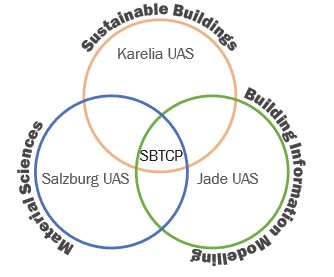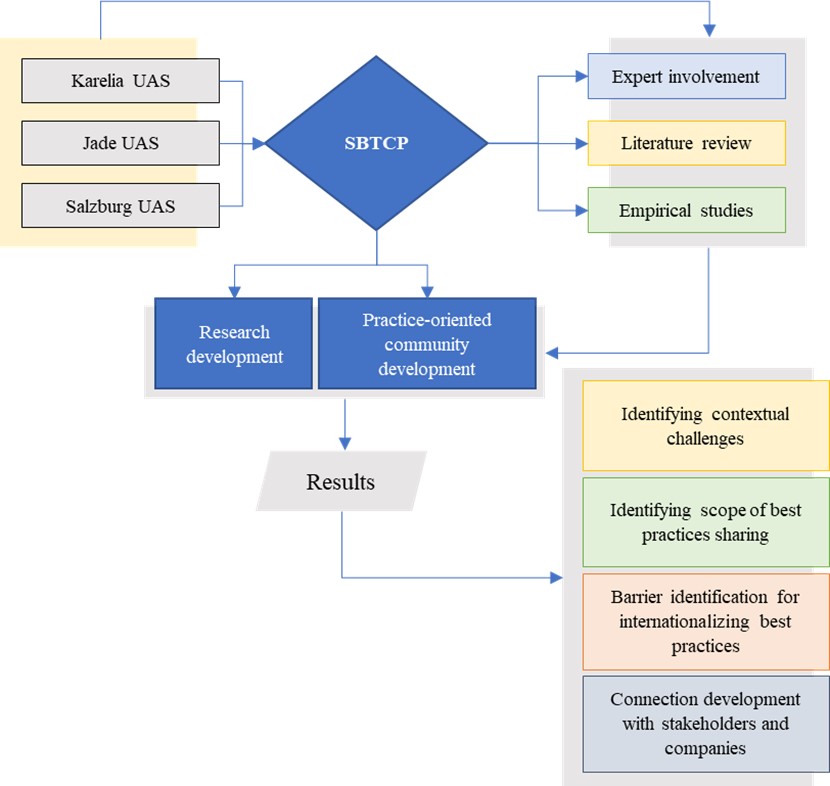Today’s world is facing a challenge due to climate change, worldwide population growth, energy demand, increased infrastructure demand, and alarming resource scarcity. The construction industry has been identified as one of the major catalysts of the adverse effects of climate change. It is crucial to reinvent the best practices through benchmarking to achieve carbon neutrality in the construction industry for better environment. The opportunity for cross-border collaboration amongst countries that share similar goals to achieve the carbon neutrality, can be a window to share updated expertise and excel in construction technology.
The following article portrays how an international collaboration project called ‘Sustainable Building Technologies- Community of Practice’ has contributed to expert community development for sustainable development, specially focusing on timber construction techniques.
Introduction
The construction industry and buildings consume about 40% of all energy and release about 30% of all carbon dioxide emissions (CO2e). This means that an increased focus on carbon-neutral construction combined with the circularity of construction residues can create a significant impact on reaching the sustainable development goals (SDGs) by 2030 set by the EU. While countries are setting ambitious goals to achieve carbon neutrality by 2030, having international perspectives/collaboration might make the route there more efficient.
According to a universal survey on how companies are now working to incorporate their activities with the SDGs by the World Business Council for Sustainable Development (WBCSD), and DNV GL (2018), SDG 13 (climate action) is the most ranked goal, and the responsible consumption and production goal (SDG 12) scored the highest percentage in Europe and the Asia-Pacific regions (Gomme & Perks, 2018). Therefore, it is important to analyse how the construction industry, being one of the most important sectors responsible for climate change and resource usage, can move towards sustainability.
There is great scope for internationalising current best practices in wood construction to enhance the competitiveness of wood construction for sustainable cities. Those questions related to information management are a particularly important area for competitiveness. A tool for information management is building information modelling (BIM), which is widely used but still needs a widely applied study. This research project aims to build a community to research effective approaches towards different real-time challenges in wood construction and reinforce wood construction knowledge in different contexts (e.g. Finland, Austria and Germany).
The article explains where international projects can contribute to a better understanding of common grounds of challenges and possible mitigation strategies. The article also explains how exploring common barriers and possibilities can help develop a cross-boundary community of advanced wood construction research and practices.
Background
There is a debate about multistorey wood construction and traditional material-based construction. The reason is that wood construction is still seen as a more expensive construction method compared to traditional ones in Europe. In addition, the adequacy of the supply chain is under question, especially for massive wood construction. However, to meet the goal of sustainable development, building construction needs to be seen in the light of the entire life cycle of buildings.
Several researchers, such as Omer & Noguchi (2019) and Ribeiro & Gonçalves (2019), have associated the expected growth of urbanisation and large cities in the coming decades with significant production of raw materials and consumption of natural resources and economic movements. Hence, this could cause adverse environmental and social impacts. Indeed, it will increase the need for green building materials for constructing new buildings and infrastructure to accommodate these expansions and to achieve overall sustainable development (Omer & Noguchi 2019).
One of the challenges here is to develop a generic platform for the comparison of different materials, which can be considered in a wide variety of contexts/countries. There is a need to develop new wood-based products to fulfil the tightening requirements of low-carbon construction. Therefore, a comparative analysis of whole-life embodied carbon and GHG emissions from multistorey buildings considering different materials (e.g. concrete, brick, wood, steel) needs further research.
The article sheds light on the current challenges towards internationalising the best practices in wood construction through expert communication located in three selected case study cities. Observations from cross-boundary expert discussions, workshops, empirical studies and literature reviews were used. The study helps to pinpoint the common ground of challenges and possible mitigation strategies for the future to develop a cross-boundary community of advanced wood construction practices.
Objectives
The article briefly explains how international collaboration in the SBTCP project (Sustainable Building Technologies – Community of Practice) has effectively contributed to the research developed by the cross-border community of professionals, companies and stakeholders from three countries: Finland, Austria and Germany.
The objectives of the article are to:
- assess and explain how the SBTCP project is internationalising wood construction knowledge and benefiting cross-border countries
- explain the common internationalisation framework of the SBTCP project for reinforcing wood construction knowledge and best practices
Methodology
The SBTCP project connects cross-border wood construction experts, resulting in two main output areas: 1) research development and 2) practice-oriented community development. While the development of the SBTCP project concerns collaboration amongst three partner universities located in three countries, the method for the project development includes expert opinions, literature review, pilot testing, and empirical studies based on observations in the selected contexts.
Results
The SBTCP project is a platform of three collaborating partner universities. The research activity of the project started by selecting research topics for collaboration by the partner universities from Finland, Austria and Germany.
The objectives of the SBTCP project are:
- Identifying key research topics in sustainable construction
- Knowledge sharing and pilot-testing solutions for the pinpointed problems from the partner countries with expert support/companies
- Workshop activities and knowledge hub development connecting with international students
- Dissemination and publications in collaboration with international partners
Figure 1 illustrates how the SBTCP project is tying together three main concepts from three different countries: 1) Sustainable Buildings, 2) Building Information Modelling, and 3) Material Sciences, from the perspective of Finland, Germany and Austria. The Venn diagram shows the overlapping areas of research opportunities through collaboration, which will potentially reinforce the expertise and knowledge of wood construction.

The possible outcomes of internationalising best practices through expert collaboration from cross-boundary organisations are as follows:
- Identification of real-time/contextual challenges
- Cross-boundary best practice sharing
- Mitigating barriers to the internationalisation process
- Connection development with stakeholders and companies
Figure 2 shows the resultant framework of the SBTCP project and how it connects three partnering universities and experts from Finland, Germany and Austria to develop the research and wood expert community. The framework leads to findings such as:
- Contextual challenges identification is required to pinpoint areas of expertise/best practice sharing,
- Identification of barriers against the internationalisation process can ease/speed up future international collaboration and boost the active involvement of stakeholders and companies.
The findings from the SBTCP framework align with the outcomes of internationalising best practices for a sustainable future.

Conclusion
The framework shown in Figure 1 indicates the need for developing common ground in cross-boundary collaborative research for effective information- and expertise-sharing. Furthermore, the framework of the SBTCP project in Figure 2 indicates the simultaneous incorporation of international experts and open up-to-date data along with hands-on experience-based insights, leading to a deeper understanding of contextual differences, challenges/barriers, commonalities, and therefore opportunities/ways of effective future collaboration. Here, international collaboration can support data collection, analysis and up-to-date expertise sharing using a common language for the long-term futuristic global utilisation of research outputs during the project period. Moreover, the research data will reinforce the global-scale knowledge of wood construction for sustainable development, which ultimately indicates the robust outcome of internationalisation of the common practices in countries all over the world.
Authors:
Shammi Akter Keya, Project Researcher, Karelia University of Applied Sciences
Timo Pakarinen, Project Manager, Lecturer, Karelia University of Applied Sciences
References:
Omer, M. & Noguchi, T. 2019. A conceptual framework for understanding the contribution of building materials in the achievement of Sustainable Development Goals (SDGs). Sustainable Cities and Society, 52, p.101869. Available at: https://doi.org/10.1016/j.scs.2019.101869
Ribeiro, P. J. G., & Gonçalves, L. (2019). Urban Resilience: A conceptual framework. Sustainable Cities and Society, 50 (May), 101625. Available at: https://doi.org/10.1016/j.scs.2019.101625.
Gomme, J., & Perks, J. (2018). Business and the SDGs: A survey of WBCSD members and Global Network partners. WBCSD. Available at: http://docs.wbcsd.org/2018/07/WBCSD_Business_and_the_SDGs.pdf
Photo by Matic Kozinc on Unsplash

